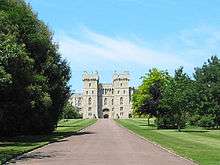Windsor Castle Act 1848
The Windsor Castle Act (1848) was a piece of UK legislation that attempted to reform the land use and rights surrounding Windsor Castle, in Berkshire, notable for its role in creating the Home Park around the modern castle.
Details
The act enacted various changes around Windsor in the light of the changing nature of Windsor Castle, the desire of Queen Victoria for greater privacy and the new railways being built in Berkshire at the time. Several new roads were to be built around the area, others sealed off, and two cast iron bridges built over the River Thames.[1] This work included the dismantling of Datchet Bridge (the Divided Bridge) and the building of two new road bridges, Victoria Bridge slightly upstream, and Albert Bridge slightly downstream. Both new bridges opened in 1851.[2] Once the crossing at Datchet was demolished, the original Windsor Road between the High Street, Datchet road and Park Street, Windsor was rerouted over Victoria Bridge and the Berkshire side became part of the private grounds of Windsor Great Park. Datchet is the only case on the entire Thames where a main bridge crossing has been completely removed.[3][4]
Consequences

The roads and bridges were built by 1850. The result was to turn the former royal estate called the Little Park around the castle into a more private estate, now called Home Park.[5]
Bibliography
- Tighe, Robert Richard and James Edward Davis. (1858) Annals of Windsor, being a history of the castle and town, with some account of Eton and places adjacent, volume II. London: Longman.
References